BUS4001: Understanding the Business Environment: TESCO Report
VerifiedAdded on 2022/12/01
|12
|3931
|224
Report
AI Summary
This report provides a comprehensive analysis of TESCO's business environment, focusing on key aspects such as its legal structure, operations, and main objectives. It examines the market structure, identifying its influence on organizational behavior and competitive advantage. The report delves into stakeholder analysis, differentiating between stakeholders and shareholders while exploring the stakeholder analysis process to identify groups, their needs, and influence. Furthermore, it includes a business environment analysis using tools like PESTEL and Porter's Five Forces to identify critical issues at domestic and international levels. The report concludes with an evaluation of business growth, considering short and long-term staging, and assesses the stability between monetary and non-monetary performance measures.
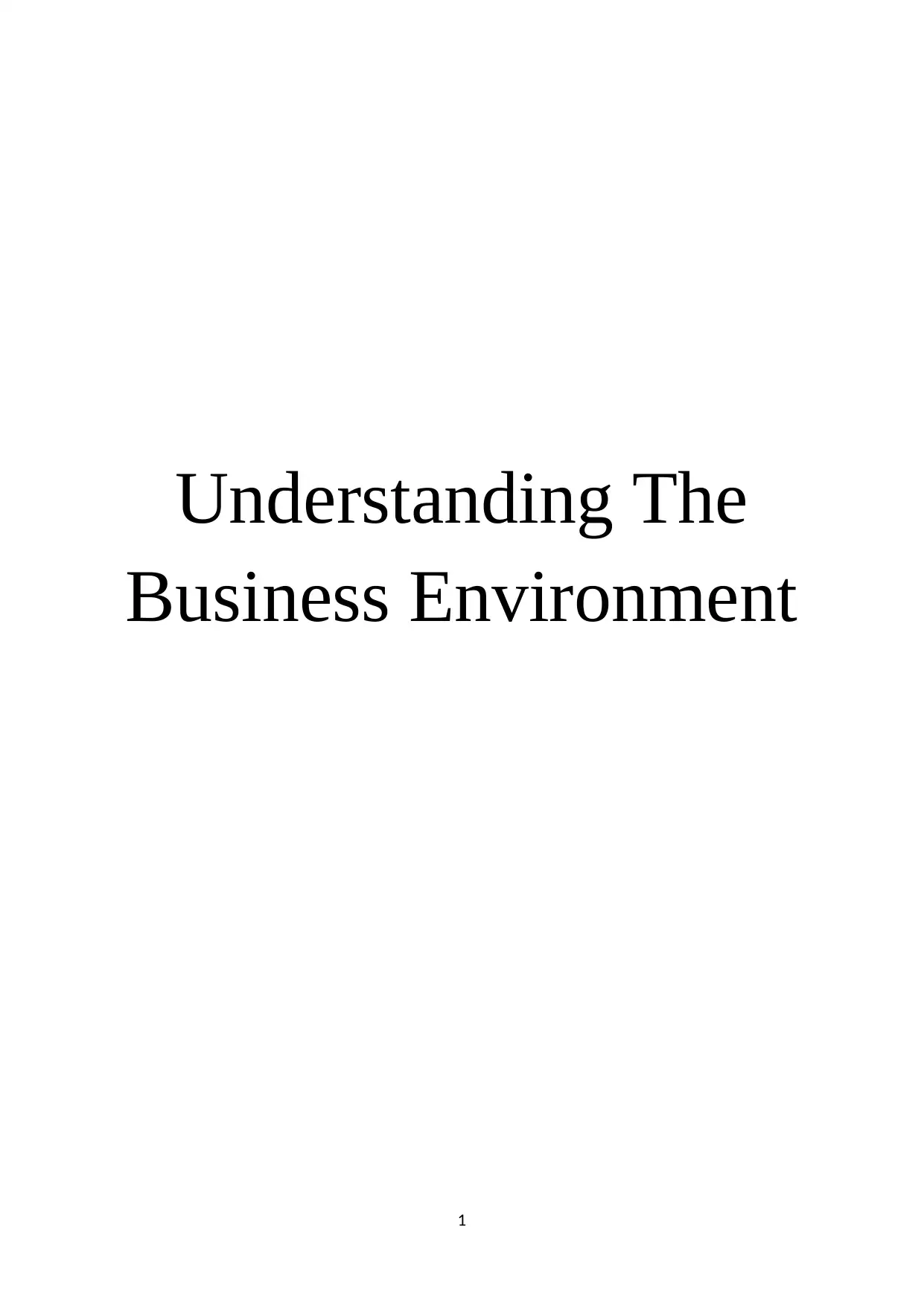
Understanding The
Business Environment
1
Business Environment
1
Paraphrase This Document
Need a fresh take? Get an instant paraphrase of this document with our AI Paraphraser
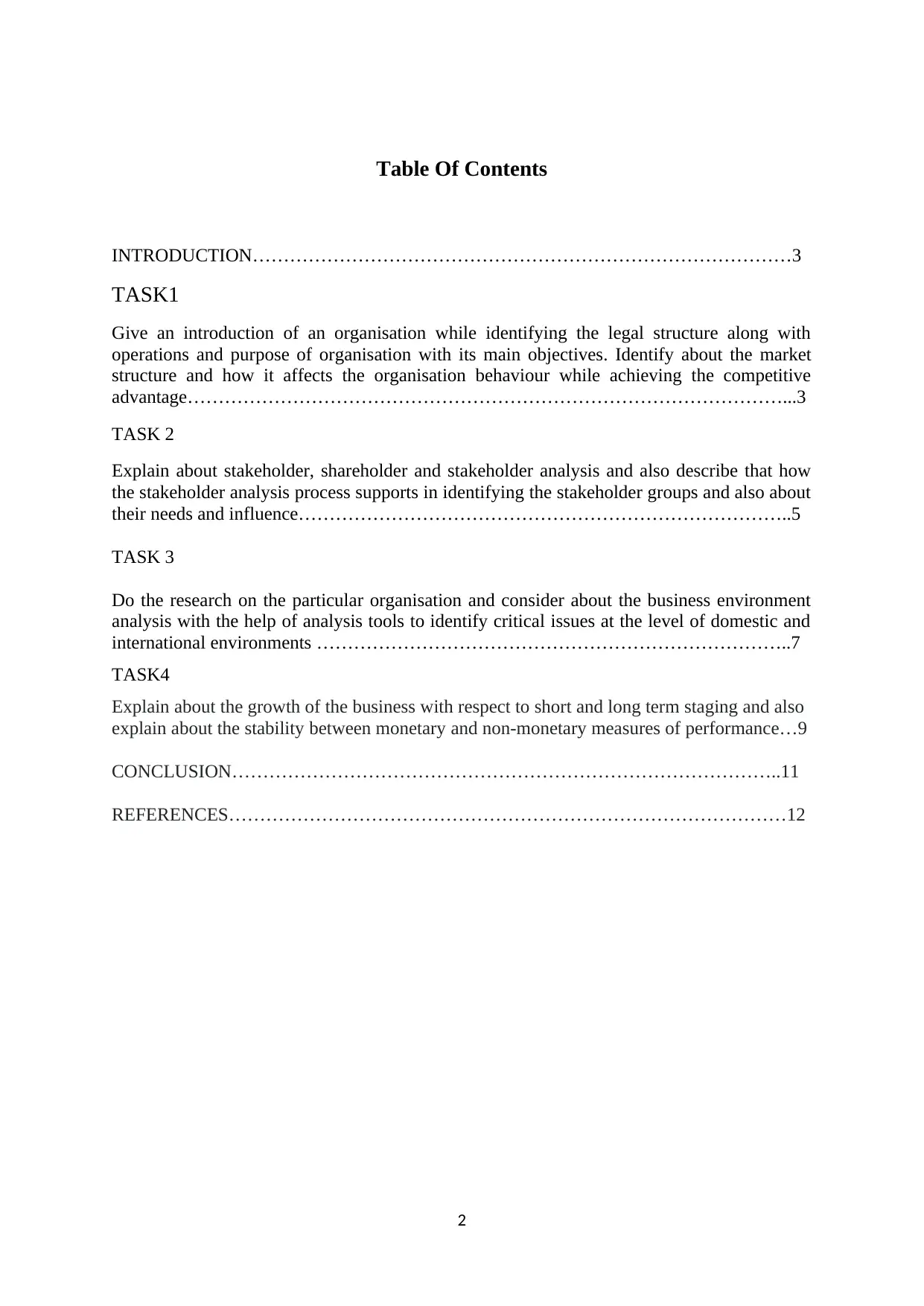
Table Of Contents
INTRODUCTION……………………………………………………………………………3
TASK1
Give an introduction of an organisation while identifying the legal structure along with
operations and purpose of organisation with its main objectives. Identify about the market
structure and how it affects the organisation behaviour while achieving the competitive
advantage……………………………………………………………………………………...3
TASK 2
Explain about stakeholder, shareholder and stakeholder analysis and also describe that how
the stakeholder analysis process supports in identifying the stakeholder groups and also about
their needs and influence……………………………………………………………………..5
TASK 3
Do the research on the particular organisation and consider about the business environment
analysis with the help of analysis tools to identify critical issues at the level of domestic and
international environments …………………………………………………………………..7
TASK4
Explain about the growth of the business with respect to short and long term staging and also
explain about the stability between monetary and non-monetary measures of performance…9
CONCLUSION……………………………………………………………………………..11
REFERENCES………………………………………………………………………………12
2
INTRODUCTION……………………………………………………………………………3
TASK1
Give an introduction of an organisation while identifying the legal structure along with
operations and purpose of organisation with its main objectives. Identify about the market
structure and how it affects the organisation behaviour while achieving the competitive
advantage……………………………………………………………………………………...3
TASK 2
Explain about stakeholder, shareholder and stakeholder analysis and also describe that how
the stakeholder analysis process supports in identifying the stakeholder groups and also about
their needs and influence……………………………………………………………………..5
TASK 3
Do the research on the particular organisation and consider about the business environment
analysis with the help of analysis tools to identify critical issues at the level of domestic and
international environments …………………………………………………………………..7
TASK4
Explain about the growth of the business with respect to short and long term staging and also
explain about the stability between monetary and non-monetary measures of performance…9
CONCLUSION……………………………………………………………………………..11
REFERENCES………………………………………………………………………………12
2
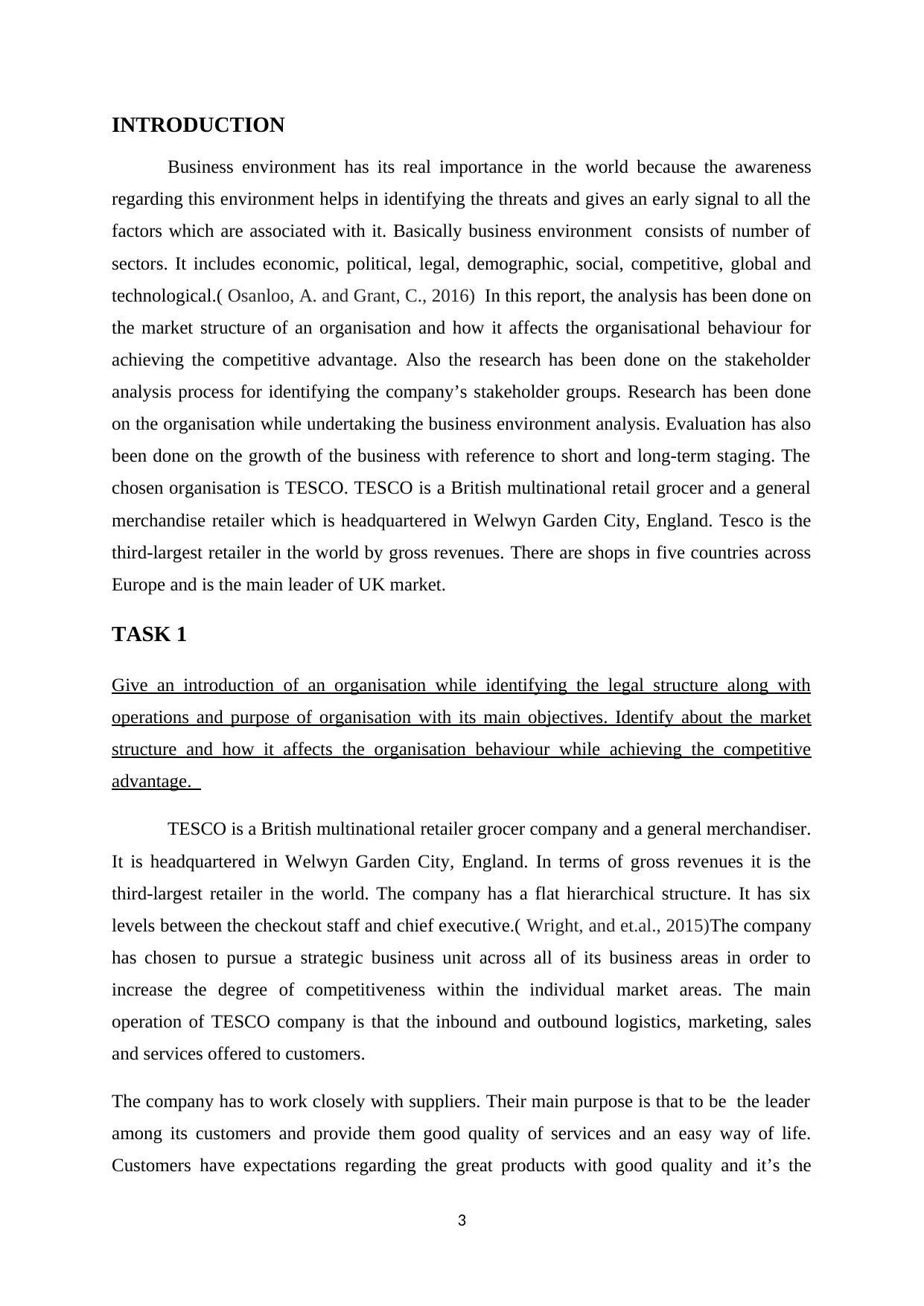
INTRODUCTION
Business environment has its real importance in the world because the awareness
regarding this environment helps in identifying the threats and gives an early signal to all the
factors which are associated with it. Basically business environment consists of number of
sectors. It includes economic, political, legal, demographic, social, competitive, global and
technological.( Osanloo, A. and Grant, C., 2016) In this report, the analysis has been done on
the market structure of an organisation and how it affects the organisational behaviour for
achieving the competitive advantage. Also the research has been done on the stakeholder
analysis process for identifying the company’s stakeholder groups. Research has been done
on the organisation while undertaking the business environment analysis. Evaluation has also
been done on the growth of the business with reference to short and long-term staging. The
chosen organisation is TESCO. TESCO is a British multinational retail grocer and a general
merchandise retailer which is headquartered in Welwyn Garden City, England. Tesco is the
third-largest retailer in the world by gross revenues. There are shops in five countries across
Europe and is the main leader of UK market.
TASK 1
Give an introduction of an organisation while identifying the legal structure along with
operations and purpose of organisation with its main objectives. Identify about the market
structure and how it affects the organisation behaviour while achieving the competitive
advantage.
TESCO is a British multinational retailer grocer company and a general merchandiser.
It is headquartered in Welwyn Garden City, England. In terms of gross revenues it is the
third-largest retailer in the world. The company has a flat hierarchical structure. It has six
levels between the checkout staff and chief executive.( Wright, and et.al., 2015)The company
has chosen to pursue a strategic business unit across all of its business areas in order to
increase the degree of competitiveness within the individual market areas. The main
operation of TESCO company is that the inbound and outbound logistics, marketing, sales
and services offered to customers.
The company has to work closely with suppliers. Their main purpose is that to be the leader
among its customers and provide them good quality of services and an easy way of life.
Customers have expectations regarding the great products with good quality and it’s the
3
Business environment has its real importance in the world because the awareness
regarding this environment helps in identifying the threats and gives an early signal to all the
factors which are associated with it. Basically business environment consists of number of
sectors. It includes economic, political, legal, demographic, social, competitive, global and
technological.( Osanloo, A. and Grant, C., 2016) In this report, the analysis has been done on
the market structure of an organisation and how it affects the organisational behaviour for
achieving the competitive advantage. Also the research has been done on the stakeholder
analysis process for identifying the company’s stakeholder groups. Research has been done
on the organisation while undertaking the business environment analysis. Evaluation has also
been done on the growth of the business with reference to short and long-term staging. The
chosen organisation is TESCO. TESCO is a British multinational retail grocer and a general
merchandise retailer which is headquartered in Welwyn Garden City, England. Tesco is the
third-largest retailer in the world by gross revenues. There are shops in five countries across
Europe and is the main leader of UK market.
TASK 1
Give an introduction of an organisation while identifying the legal structure along with
operations and purpose of organisation with its main objectives. Identify about the market
structure and how it affects the organisation behaviour while achieving the competitive
advantage.
TESCO is a British multinational retailer grocer company and a general merchandiser.
It is headquartered in Welwyn Garden City, England. In terms of gross revenues it is the
third-largest retailer in the world. The company has a flat hierarchical structure. It has six
levels between the checkout staff and chief executive.( Wright, and et.al., 2015)The company
has chosen to pursue a strategic business unit across all of its business areas in order to
increase the degree of competitiveness within the individual market areas. The main
operation of TESCO company is that the inbound and outbound logistics, marketing, sales
and services offered to customers.
The company has to work closely with suppliers. Their main purpose is that to be the leader
among its customers and provide them good quality of services and an easy way of life.
Customers have expectations regarding the great products with good quality and it’s the
3
⊘ This is a preview!⊘
Do you want full access?
Subscribe today to unlock all pages.

Trusted by 1+ million students worldwide
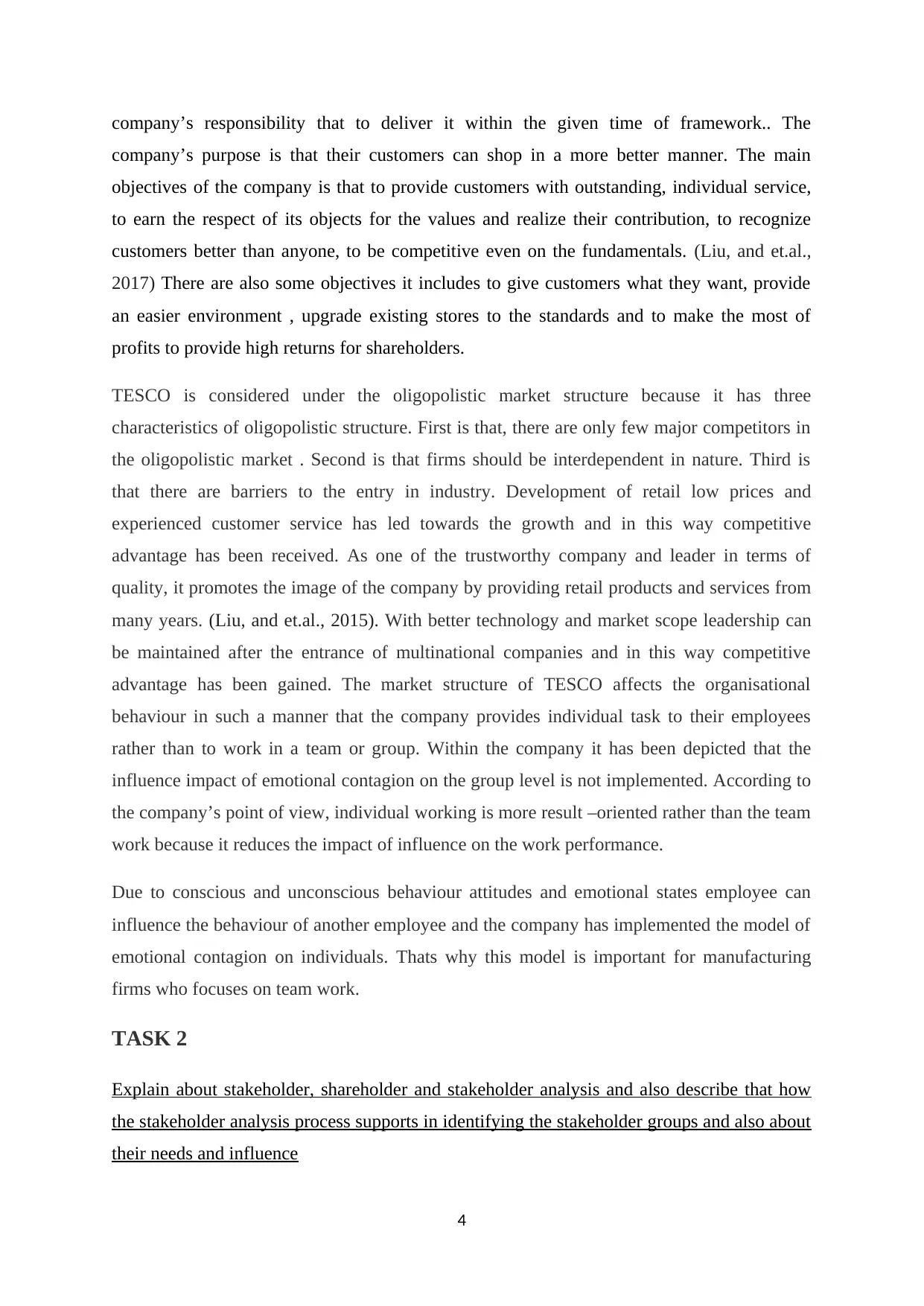
company’s responsibility that to deliver it within the given time of framework.. The
company’s purpose is that their customers can shop in a more better manner. The main
objectives of the company is that to provide customers with outstanding, individual service,
to earn the respect of its objects for the values and realize their contribution, to recognize
customers better than anyone, to be competitive even on the fundamentals. (Liu, and et.al.,
2017) There are also some objectives it includes to give customers what they want, provide
an easier environment , upgrade existing stores to the standards and to make the most of
profits to provide high returns for shareholders.
TESCO is considered under the oligopolistic market structure because it has three
characteristics of oligopolistic structure. First is that, there are only few major competitors in
the oligopolistic market . Second is that firms should be interdependent in nature. Third is
that there are barriers to the entry in industry. Development of retail low prices and
experienced customer service has led towards the growth and in this way competitive
advantage has been received. As one of the trustworthy company and leader in terms of
quality, it promotes the image of the company by providing retail products and services from
many years. (Liu, and et.al., 2015). With better technology and market scope leadership can
be maintained after the entrance of multinational companies and in this way competitive
advantage has been gained. The market structure of TESCO affects the organisational
behaviour in such a manner that the company provides individual task to their employees
rather than to work in a team or group. Within the company it has been depicted that the
influence impact of emotional contagion on the group level is not implemented. According to
the company’s point of view, individual working is more result –oriented rather than the team
work because it reduces the impact of influence on the work performance.
Due to conscious and unconscious behaviour attitudes and emotional states employee can
influence the behaviour of another employee and the company has implemented the model of
emotional contagion on individuals. Thats why this model is important for manufacturing
firms who focuses on team work.
TASK 2
Explain about stakeholder, shareholder and stakeholder analysis and also describe that how
the stakeholder analysis process supports in identifying the stakeholder groups and also about
their needs and influence
4
company’s purpose is that their customers can shop in a more better manner. The main
objectives of the company is that to provide customers with outstanding, individual service,
to earn the respect of its objects for the values and realize their contribution, to recognize
customers better than anyone, to be competitive even on the fundamentals. (Liu, and et.al.,
2017) There are also some objectives it includes to give customers what they want, provide
an easier environment , upgrade existing stores to the standards and to make the most of
profits to provide high returns for shareholders.
TESCO is considered under the oligopolistic market structure because it has three
characteristics of oligopolistic structure. First is that, there are only few major competitors in
the oligopolistic market . Second is that firms should be interdependent in nature. Third is
that there are barriers to the entry in industry. Development of retail low prices and
experienced customer service has led towards the growth and in this way competitive
advantage has been received. As one of the trustworthy company and leader in terms of
quality, it promotes the image of the company by providing retail products and services from
many years. (Liu, and et.al., 2015). With better technology and market scope leadership can
be maintained after the entrance of multinational companies and in this way competitive
advantage has been gained. The market structure of TESCO affects the organisational
behaviour in such a manner that the company provides individual task to their employees
rather than to work in a team or group. Within the company it has been depicted that the
influence impact of emotional contagion on the group level is not implemented. According to
the company’s point of view, individual working is more result –oriented rather than the team
work because it reduces the impact of influence on the work performance.
Due to conscious and unconscious behaviour attitudes and emotional states employee can
influence the behaviour of another employee and the company has implemented the model of
emotional contagion on individuals. Thats why this model is important for manufacturing
firms who focuses on team work.
TASK 2
Explain about stakeholder, shareholder and stakeholder analysis and also describe that how
the stakeholder analysis process supports in identifying the stakeholder groups and also about
their needs and influence
4
Paraphrase This Document
Need a fresh take? Get an instant paraphrase of this document with our AI Paraphraser
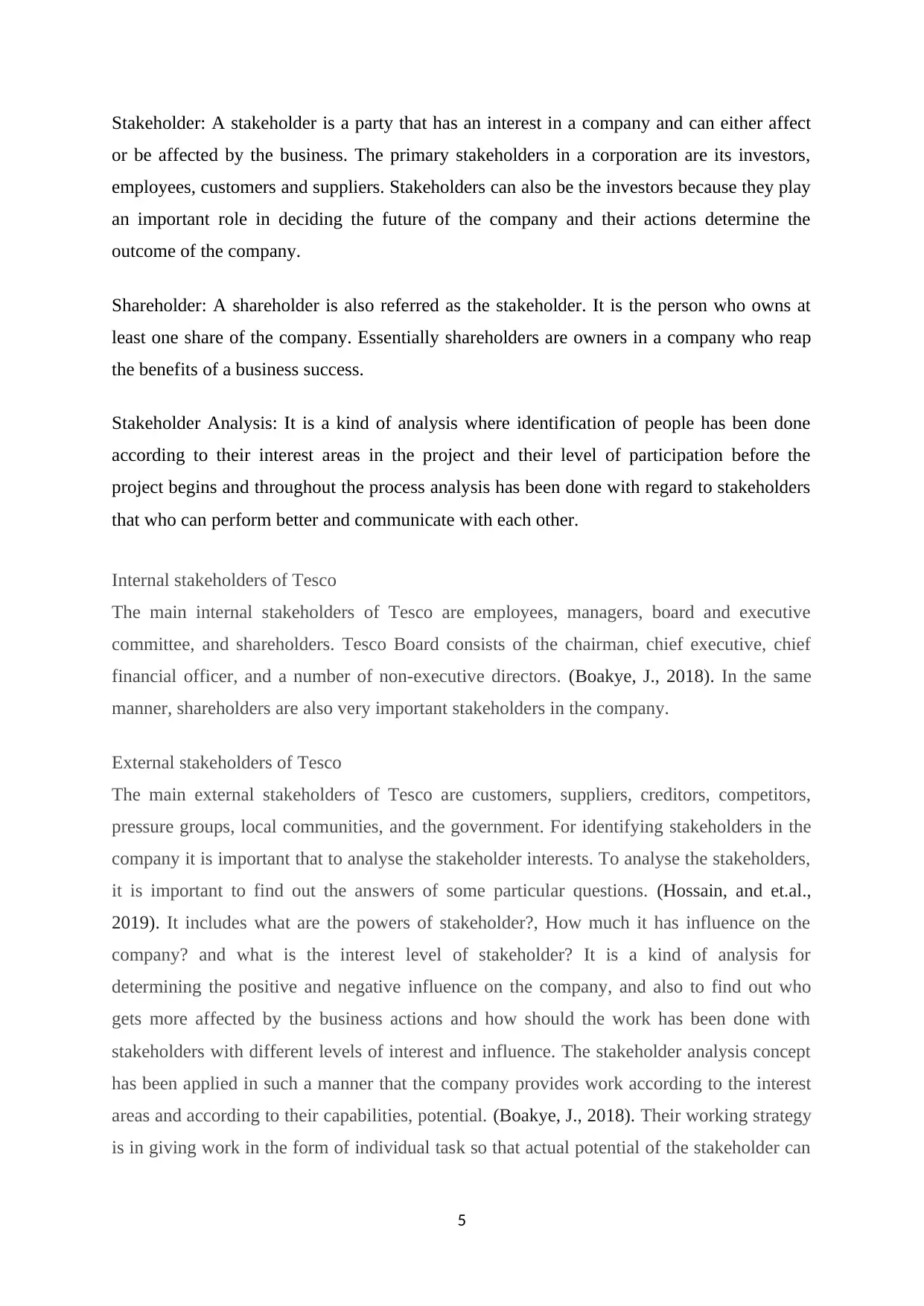
Stakeholder: A stakeholder is a party that has an interest in a company and can either affect
or be affected by the business. The primary stakeholders in a corporation are its investors,
employees, customers and suppliers. Stakeholders can also be the investors because they play
an important role in deciding the future of the company and their actions determine the
outcome of the company.
Shareholder: A shareholder is also referred as the stakeholder. It is the person who owns at
least one share of the company. Essentially shareholders are owners in a company who reap
the benefits of a business success.
Stakeholder Analysis: It is a kind of analysis where identification of people has been done
according to their interest areas in the project and their level of participation before the
project begins and throughout the process analysis has been done with regard to stakeholders
that who can perform better and communicate with each other.
Internal stakeholders of Tesco
The main internal stakeholders of Tesco are employees, managers, board and executive
committee, and shareholders. Tesco Board consists of the chairman, chief executive, chief
financial officer, and a number of non-executive directors. (Boakye, J., 2018). In the same
manner, shareholders are also very important stakeholders in the company.
External stakeholders of Tesco
The main external stakeholders of Tesco are customers, suppliers, creditors, competitors,
pressure groups, local communities, and the government. For identifying stakeholders in the
company it is important that to analyse the stakeholder interests. To analyse the stakeholders,
it is important to find out the answers of some particular questions. (Hossain, and et.al.,
2019). It includes what are the powers of stakeholder?, How much it has influence on the
company? and what is the interest level of stakeholder? It is a kind of analysis for
determining the positive and negative influence on the company, and also to find out who
gets more affected by the business actions and how should the work has been done with
stakeholders with different levels of interest and influence. The stakeholder analysis concept
has been applied in such a manner that the company provides work according to the interest
areas and according to their capabilities, potential. (Boakye, J., 2018). Their working strategy
is in giving work in the form of individual task so that actual potential of the stakeholder can
5
or be affected by the business. The primary stakeholders in a corporation are its investors,
employees, customers and suppliers. Stakeholders can also be the investors because they play
an important role in deciding the future of the company and their actions determine the
outcome of the company.
Shareholder: A shareholder is also referred as the stakeholder. It is the person who owns at
least one share of the company. Essentially shareholders are owners in a company who reap
the benefits of a business success.
Stakeholder Analysis: It is a kind of analysis where identification of people has been done
according to their interest areas in the project and their level of participation before the
project begins and throughout the process analysis has been done with regard to stakeholders
that who can perform better and communicate with each other.
Internal stakeholders of Tesco
The main internal stakeholders of Tesco are employees, managers, board and executive
committee, and shareholders. Tesco Board consists of the chairman, chief executive, chief
financial officer, and a number of non-executive directors. (Boakye, J., 2018). In the same
manner, shareholders are also very important stakeholders in the company.
External stakeholders of Tesco
The main external stakeholders of Tesco are customers, suppliers, creditors, competitors,
pressure groups, local communities, and the government. For identifying stakeholders in the
company it is important that to analyse the stakeholder interests. To analyse the stakeholders,
it is important to find out the answers of some particular questions. (Hossain, and et.al.,
2019). It includes what are the powers of stakeholder?, How much it has influence on the
company? and what is the interest level of stakeholder? It is a kind of analysis for
determining the positive and negative influence on the company, and also to find out who
gets more affected by the business actions and how should the work has been done with
stakeholders with different levels of interest and influence. The stakeholder analysis concept
has been applied in such a manner that the company provides work according to the interest
areas and according to their capabilities, potential. (Boakye, J., 2018). Their working strategy
is in giving work in the form of individual task so that actual potential of the stakeholder can
5
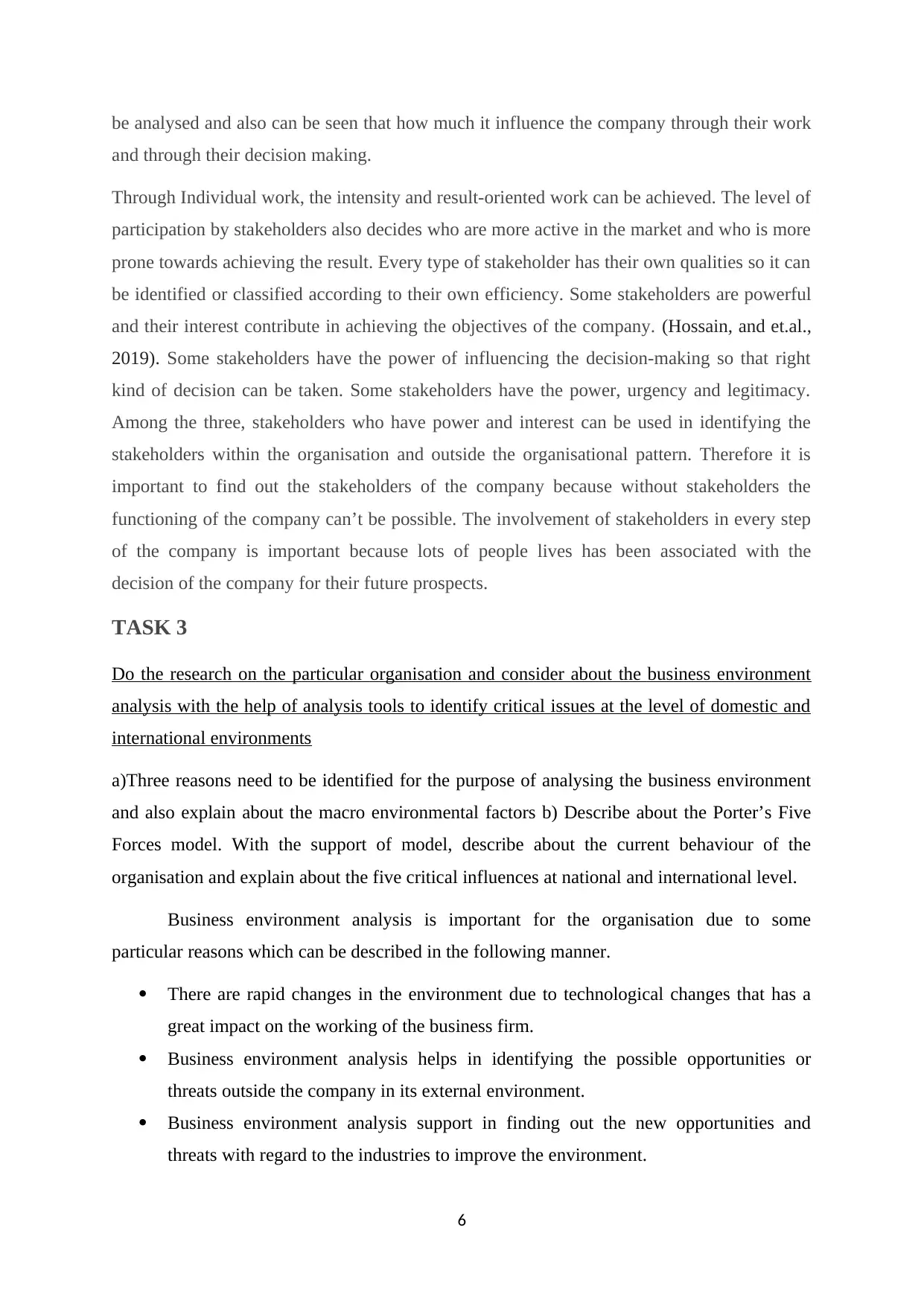
be analysed and also can be seen that how much it influence the company through their work
and through their decision making.
Through Individual work, the intensity and result-oriented work can be achieved. The level of
participation by stakeholders also decides who are more active in the market and who is more
prone towards achieving the result. Every type of stakeholder has their own qualities so it can
be identified or classified according to their own efficiency. Some stakeholders are powerful
and their interest contribute in achieving the objectives of the company. (Hossain, and et.al.,
2019). Some stakeholders have the power of influencing the decision-making so that right
kind of decision can be taken. Some stakeholders have the power, urgency and legitimacy.
Among the three, stakeholders who have power and interest can be used in identifying the
stakeholders within the organisation and outside the organisational pattern. Therefore it is
important to find out the stakeholders of the company because without stakeholders the
functioning of the company can’t be possible. The involvement of stakeholders in every step
of the company is important because lots of people lives has been associated with the
decision of the company for their future prospects.
TASK 3
Do the research on the particular organisation and consider about the business environment
analysis with the help of analysis tools to identify critical issues at the level of domestic and
international environments
a)Three reasons need to be identified for the purpose of analysing the business environment
and also explain about the macro environmental factors b) Describe about the Porter’s Five
Forces model. With the support of model, describe about the current behaviour of the
organisation and explain about the five critical influences at national and international level.
Business environment analysis is important for the organisation due to some
particular reasons which can be described in the following manner.
There are rapid changes in the environment due to technological changes that has a
great impact on the working of the business firm.
Business environment analysis helps in identifying the possible opportunities or
threats outside the company in its external environment.
Business environment analysis support in finding out the new opportunities and
threats with regard to the industries to improve the environment.
6
and through their decision making.
Through Individual work, the intensity and result-oriented work can be achieved. The level of
participation by stakeholders also decides who are more active in the market and who is more
prone towards achieving the result. Every type of stakeholder has their own qualities so it can
be identified or classified according to their own efficiency. Some stakeholders are powerful
and their interest contribute in achieving the objectives of the company. (Hossain, and et.al.,
2019). Some stakeholders have the power of influencing the decision-making so that right
kind of decision can be taken. Some stakeholders have the power, urgency and legitimacy.
Among the three, stakeholders who have power and interest can be used in identifying the
stakeholders within the organisation and outside the organisational pattern. Therefore it is
important to find out the stakeholders of the company because without stakeholders the
functioning of the company can’t be possible. The involvement of stakeholders in every step
of the company is important because lots of people lives has been associated with the
decision of the company for their future prospects.
TASK 3
Do the research on the particular organisation and consider about the business environment
analysis with the help of analysis tools to identify critical issues at the level of domestic and
international environments
a)Three reasons need to be identified for the purpose of analysing the business environment
and also explain about the macro environmental factors b) Describe about the Porter’s Five
Forces model. With the support of model, describe about the current behaviour of the
organisation and explain about the five critical influences at national and international level.
Business environment analysis is important for the organisation due to some
particular reasons which can be described in the following manner.
There are rapid changes in the environment due to technological changes that has a
great impact on the working of the business firm.
Business environment analysis helps in identifying the possible opportunities or
threats outside the company in its external environment.
Business environment analysis support in finding out the new opportunities and
threats with regard to the industries to improve the environment.
6
⊘ This is a preview!⊘
Do you want full access?
Subscribe today to unlock all pages.

Trusted by 1+ million students worldwide
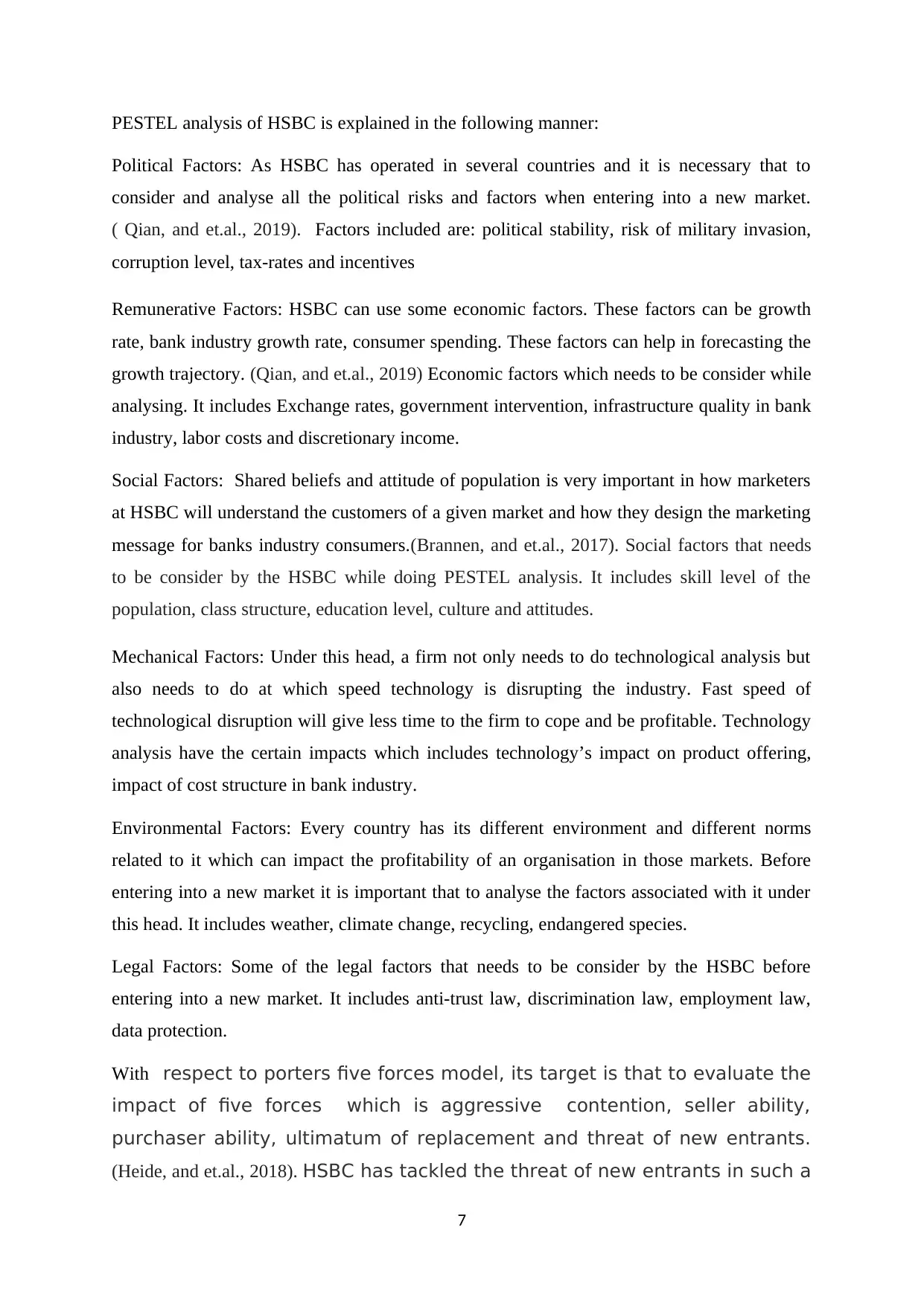
PESTEL analysis of HSBC is explained in the following manner:
Political Factors: As HSBC has operated in several countries and it is necessary that to
consider and analyse all the political risks and factors when entering into a new market.
( Qian, and et.al., 2019). Factors included are: political stability, risk of military invasion,
corruption level, tax-rates and incentives
Remunerative Factors: HSBC can use some economic factors. These factors can be growth
rate, bank industry growth rate, consumer spending. These factors can help in forecasting the
growth trajectory. (Qian, and et.al., 2019) Economic factors which needs to be consider while
analysing. It includes Exchange rates, government intervention, infrastructure quality in bank
industry, labor costs and discretionary income.
Social Factors: Shared beliefs and attitude of population is very important in how marketers
at HSBC will understand the customers of a given market and how they design the marketing
message for banks industry consumers.(Brannen, and et.al., 2017). Social factors that needs
to be consider by the HSBC while doing PESTEL analysis. It includes skill level of the
population, class structure, education level, culture and attitudes.
Mechanical Factors: Under this head, a firm not only needs to do technological analysis but
also needs to do at which speed technology is disrupting the industry. Fast speed of
technological disruption will give less time to the firm to cope and be profitable. Technology
analysis have the certain impacts which includes technology’s impact on product offering,
impact of cost structure in bank industry.
Environmental Factors: Every country has its different environment and different norms
related to it which can impact the profitability of an organisation in those markets. Before
entering into a new market it is important that to analyse the factors associated with it under
this head. It includes weather, climate change, recycling, endangered species.
Legal Factors: Some of the legal factors that needs to be consider by the HSBC before
entering into a new market. It includes anti-trust law, discrimination law, employment law,
data protection.
With respect to porters five forces model, its target is that to evaluate the
impact of five forces which is aggressive contention, seller ability,
purchaser ability, ultimatum of replacement and threat of new entrants.
(Heide, and et.al., 2018). HSBC has tackled the threat of new entrants in such a
7
Political Factors: As HSBC has operated in several countries and it is necessary that to
consider and analyse all the political risks and factors when entering into a new market.
( Qian, and et.al., 2019). Factors included are: political stability, risk of military invasion,
corruption level, tax-rates and incentives
Remunerative Factors: HSBC can use some economic factors. These factors can be growth
rate, bank industry growth rate, consumer spending. These factors can help in forecasting the
growth trajectory. (Qian, and et.al., 2019) Economic factors which needs to be consider while
analysing. It includes Exchange rates, government intervention, infrastructure quality in bank
industry, labor costs and discretionary income.
Social Factors: Shared beliefs and attitude of population is very important in how marketers
at HSBC will understand the customers of a given market and how they design the marketing
message for banks industry consumers.(Brannen, and et.al., 2017). Social factors that needs
to be consider by the HSBC while doing PESTEL analysis. It includes skill level of the
population, class structure, education level, culture and attitudes.
Mechanical Factors: Under this head, a firm not only needs to do technological analysis but
also needs to do at which speed technology is disrupting the industry. Fast speed of
technological disruption will give less time to the firm to cope and be profitable. Technology
analysis have the certain impacts which includes technology’s impact on product offering,
impact of cost structure in bank industry.
Environmental Factors: Every country has its different environment and different norms
related to it which can impact the profitability of an organisation in those markets. Before
entering into a new market it is important that to analyse the factors associated with it under
this head. It includes weather, climate change, recycling, endangered species.
Legal Factors: Some of the legal factors that needs to be consider by the HSBC before
entering into a new market. It includes anti-trust law, discrimination law, employment law,
data protection.
With respect to porters five forces model, its target is that to evaluate the
impact of five forces which is aggressive contention, seller ability,
purchaser ability, ultimatum of replacement and threat of new entrants.
(Heide, and et.al., 2018). HSBC has tackled the threat of new entrants in such a
7
Paraphrase This Document
Need a fresh take? Get an instant paraphrase of this document with our AI Paraphraser
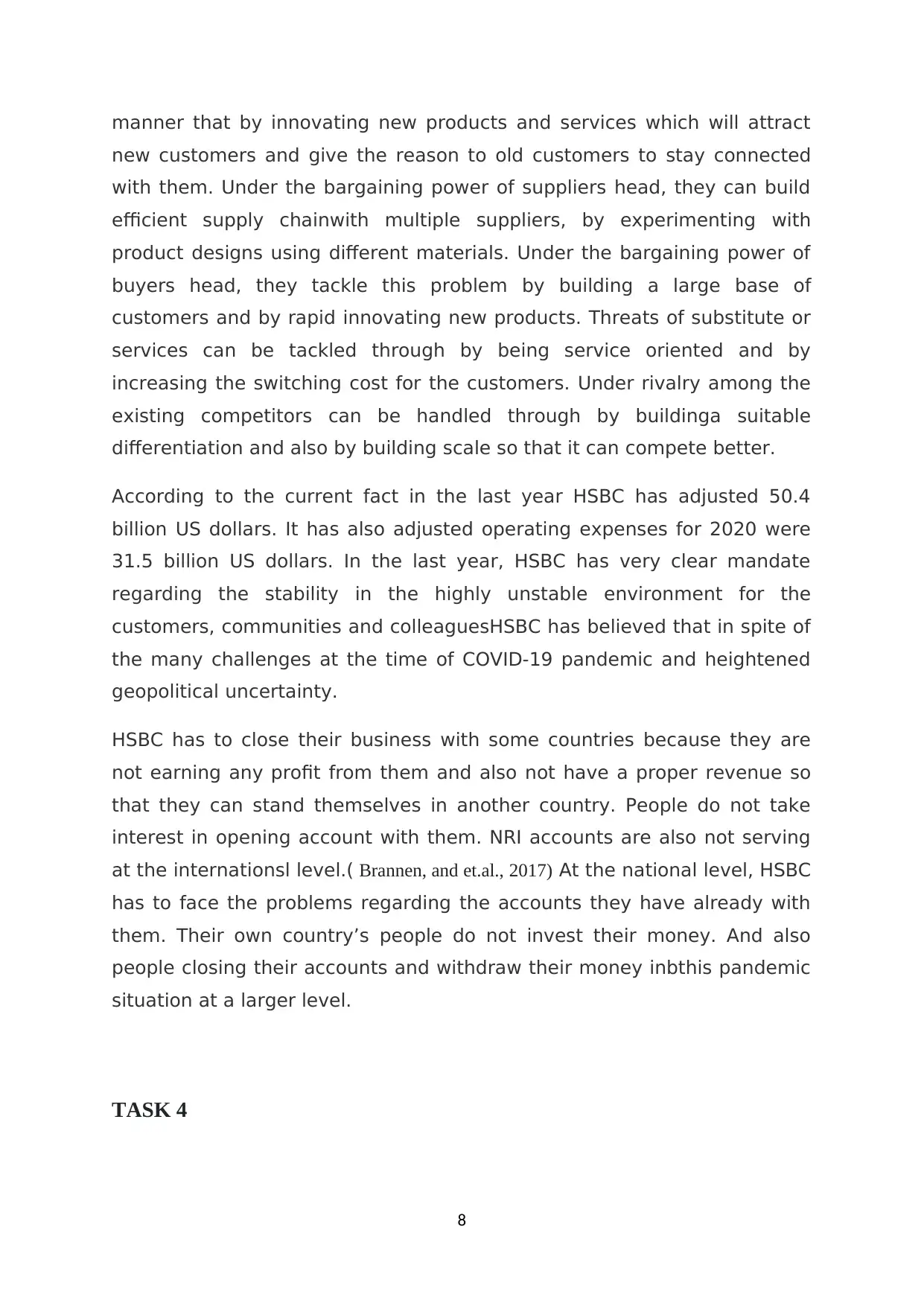
manner that by innovating new products and services which will attract
new customers and give the reason to old customers to stay connected
with them. Under the bargaining power of suppliers head, they can build
efficient supply chainwith multiple suppliers, by experimenting with
product designs using different materials. Under the bargaining power of
buyers head, they tackle this problem by building a large base of
customers and by rapid innovating new products. Threats of substitute or
services can be tackled through by being service oriented and by
increasing the switching cost for the customers. Under rivalry among the
existing competitors can be handled through by buildinga suitable
differentiation and also by building scale so that it can compete better.
According to the current fact in the last year HSBC has adjusted 50.4
billion US dollars. It has also adjusted operating expenses for 2020 were
31.5 billion US dollars. In the last year, HSBC has very clear mandate
regarding the stability in the highly unstable environment for the
customers, communities and colleaguesHSBC has believed that in spite of
the many challenges at the time of COVID-19 pandemic and heightened
geopolitical uncertainty.
HSBC has to close their business with some countries because they are
not earning any profit from them and also not have a proper revenue so
that they can stand themselves in another country. People do not take
interest in opening account with them. NRI accounts are also not serving
at the internationsl level.( Brannen, and et.al., 2017) At the national level, HSBC
has to face the problems regarding the accounts they have already with
them. Their own country’s people do not invest their money. And also
people closing their accounts and withdraw their money inbthis pandemic
situation at a larger level.
TASK 4
8
new customers and give the reason to old customers to stay connected
with them. Under the bargaining power of suppliers head, they can build
efficient supply chainwith multiple suppliers, by experimenting with
product designs using different materials. Under the bargaining power of
buyers head, they tackle this problem by building a large base of
customers and by rapid innovating new products. Threats of substitute or
services can be tackled through by being service oriented and by
increasing the switching cost for the customers. Under rivalry among the
existing competitors can be handled through by buildinga suitable
differentiation and also by building scale so that it can compete better.
According to the current fact in the last year HSBC has adjusted 50.4
billion US dollars. It has also adjusted operating expenses for 2020 were
31.5 billion US dollars. In the last year, HSBC has very clear mandate
regarding the stability in the highly unstable environment for the
customers, communities and colleaguesHSBC has believed that in spite of
the many challenges at the time of COVID-19 pandemic and heightened
geopolitical uncertainty.
HSBC has to close their business with some countries because they are
not earning any profit from them and also not have a proper revenue so
that they can stand themselves in another country. People do not take
interest in opening account with them. NRI accounts are also not serving
at the internationsl level.( Brannen, and et.al., 2017) At the national level, HSBC
has to face the problems regarding the accounts they have already with
them. Their own country’s people do not invest their money. And also
people closing their accounts and withdraw their money inbthis pandemic
situation at a larger level.
TASK 4
8
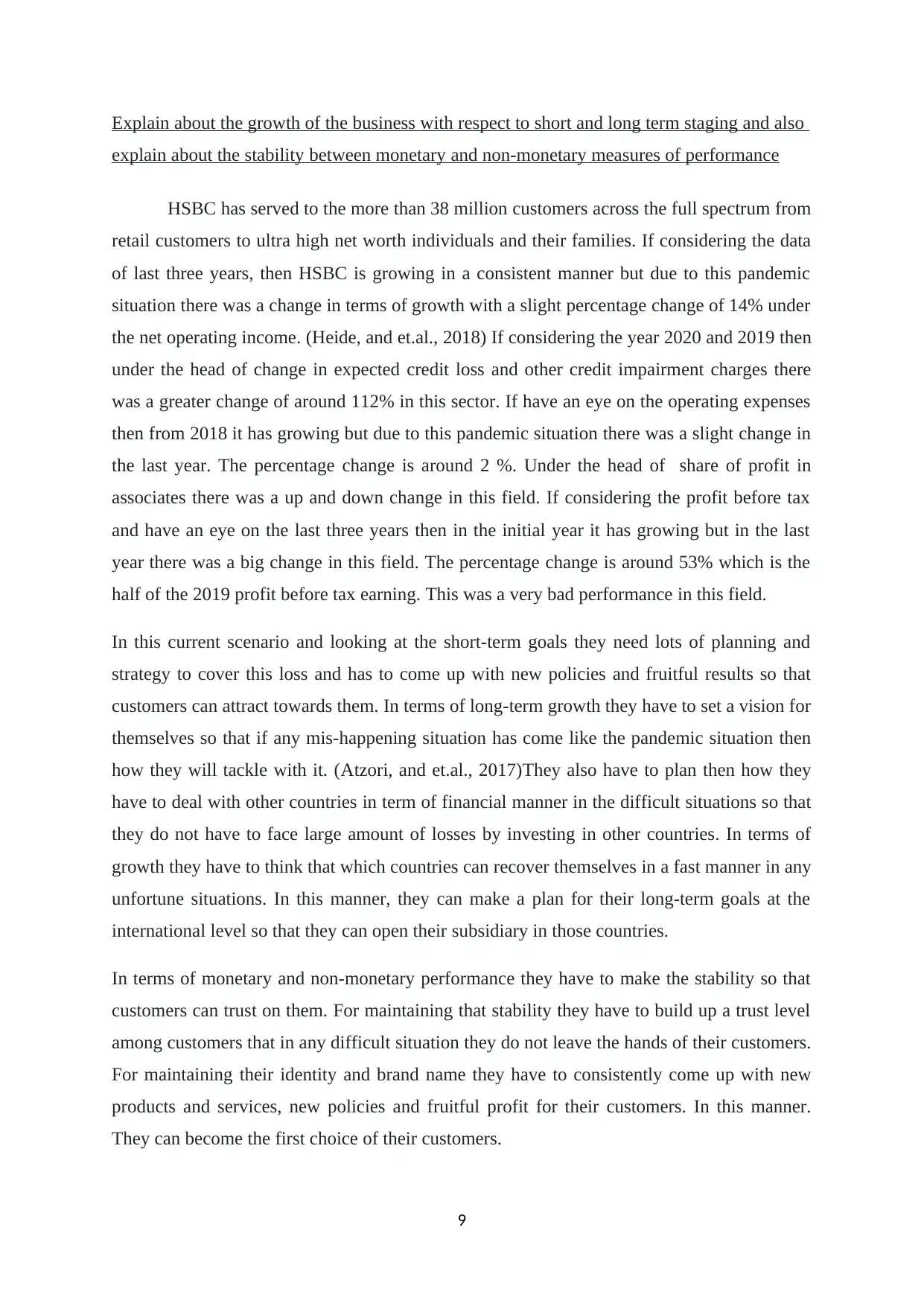
Explain about the growth of the business with respect to short and long term staging and also
explain about the stability between monetary and non-monetary measures of performance
HSBC has served to the more than 38 million customers across the full spectrum from
retail customers to ultra high net worth individuals and their families. If considering the data
of last three years, then HSBC is growing in a consistent manner but due to this pandemic
situation there was a change in terms of growth with a slight percentage change of 14% under
the net operating income. (Heide, and et.al., 2018) If considering the year 2020 and 2019 then
under the head of change in expected credit loss and other credit impairment charges there
was a greater change of around 112% in this sector. If have an eye on the operating expenses
then from 2018 it has growing but due to this pandemic situation there was a slight change in
the last year. The percentage change is around 2 %. Under the head of share of profit in
associates there was a up and down change in this field. If considering the profit before tax
and have an eye on the last three years then in the initial year it has growing but in the last
year there was a big change in this field. The percentage change is around 53% which is the
half of the 2019 profit before tax earning. This was a very bad performance in this field.
In this current scenario and looking at the short-term goals they need lots of planning and
strategy to cover this loss and has to come up with new policies and fruitful results so that
customers can attract towards them. In terms of long-term growth they have to set a vision for
themselves so that if any mis-happening situation has come like the pandemic situation then
how they will tackle with it. (Atzori, and et.al., 2017)They also have to plan then how they
have to deal with other countries in term of financial manner in the difficult situations so that
they do not have to face large amount of losses by investing in other countries. In terms of
growth they have to think that which countries can recover themselves in a fast manner in any
unfortune situations. In this manner, they can make a plan for their long-term goals at the
international level so that they can open their subsidiary in those countries.
In terms of monetary and non-monetary performance they have to make the stability so that
customers can trust on them. For maintaining that stability they have to build up a trust level
among customers that in any difficult situation they do not leave the hands of their customers.
For maintaining their identity and brand name they have to consistently come up with new
products and services, new policies and fruitful profit for their customers. In this manner.
They can become the first choice of their customers.
9
explain about the stability between monetary and non-monetary measures of performance
HSBC has served to the more than 38 million customers across the full spectrum from
retail customers to ultra high net worth individuals and their families. If considering the data
of last three years, then HSBC is growing in a consistent manner but due to this pandemic
situation there was a change in terms of growth with a slight percentage change of 14% under
the net operating income. (Heide, and et.al., 2018) If considering the year 2020 and 2019 then
under the head of change in expected credit loss and other credit impairment charges there
was a greater change of around 112% in this sector. If have an eye on the operating expenses
then from 2018 it has growing but due to this pandemic situation there was a slight change in
the last year. The percentage change is around 2 %. Under the head of share of profit in
associates there was a up and down change in this field. If considering the profit before tax
and have an eye on the last three years then in the initial year it has growing but in the last
year there was a big change in this field. The percentage change is around 53% which is the
half of the 2019 profit before tax earning. This was a very bad performance in this field.
In this current scenario and looking at the short-term goals they need lots of planning and
strategy to cover this loss and has to come up with new policies and fruitful results so that
customers can attract towards them. In terms of long-term growth they have to set a vision for
themselves so that if any mis-happening situation has come like the pandemic situation then
how they will tackle with it. (Atzori, and et.al., 2017)They also have to plan then how they
have to deal with other countries in term of financial manner in the difficult situations so that
they do not have to face large amount of losses by investing in other countries. In terms of
growth they have to think that which countries can recover themselves in a fast manner in any
unfortune situations. In this manner, they can make a plan for their long-term goals at the
international level so that they can open their subsidiary in those countries.
In terms of monetary and non-monetary performance they have to make the stability so that
customers can trust on them. For maintaining that stability they have to build up a trust level
among customers that in any difficult situation they do not leave the hands of their customers.
For maintaining their identity and brand name they have to consistently come up with new
products and services, new policies and fruitful profit for their customers. In this manner.
They can become the first choice of their customers.
9
⊘ This is a preview!⊘
Do you want full access?
Subscribe today to unlock all pages.

Trusted by 1+ million students worldwide
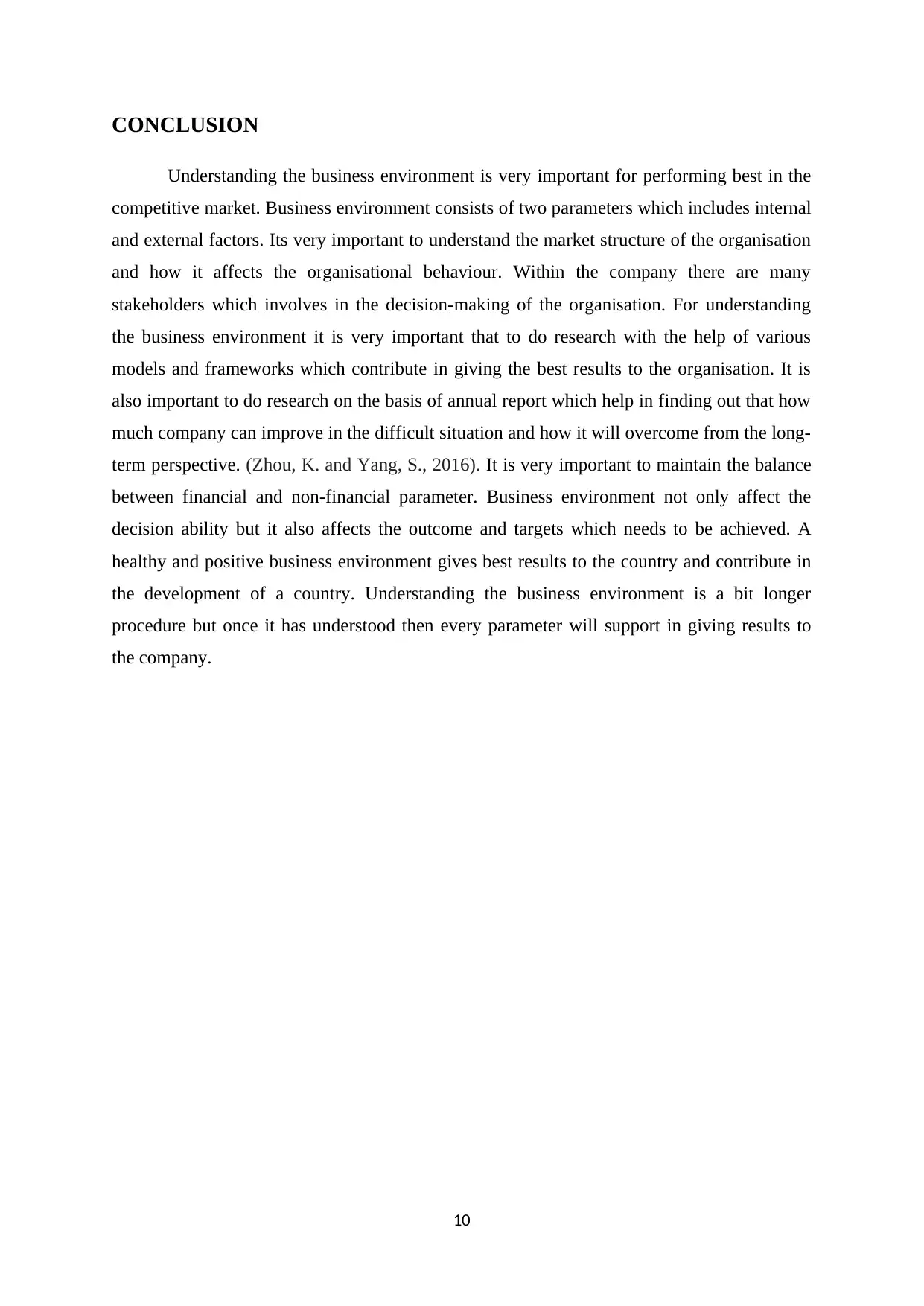
CONCLUSION
Understanding the business environment is very important for performing best in the
competitive market. Business environment consists of two parameters which includes internal
and external factors. Its very important to understand the market structure of the organisation
and how it affects the organisational behaviour. Within the company there are many
stakeholders which involves in the decision-making of the organisation. For understanding
the business environment it is very important that to do research with the help of various
models and frameworks which contribute in giving the best results to the organisation. It is
also important to do research on the basis of annual report which help in finding out that how
much company can improve in the difficult situation and how it will overcome from the long-
term perspective. (Zhou, K. and Yang, S., 2016). It is very important to maintain the balance
between financial and non-financial parameter. Business environment not only affect the
decision ability but it also affects the outcome and targets which needs to be achieved. A
healthy and positive business environment gives best results to the country and contribute in
the development of a country. Understanding the business environment is a bit longer
procedure but once it has understood then every parameter will support in giving results to
the company.
10
Understanding the business environment is very important for performing best in the
competitive market. Business environment consists of two parameters which includes internal
and external factors. Its very important to understand the market structure of the organisation
and how it affects the organisational behaviour. Within the company there are many
stakeholders which involves in the decision-making of the organisation. For understanding
the business environment it is very important that to do research with the help of various
models and frameworks which contribute in giving the best results to the organisation. It is
also important to do research on the basis of annual report which help in finding out that how
much company can improve in the difficult situation and how it will overcome from the long-
term perspective. (Zhou, K. and Yang, S., 2016). It is very important to maintain the balance
between financial and non-financial parameter. Business environment not only affect the
decision ability but it also affects the outcome and targets which needs to be achieved. A
healthy and positive business environment gives best results to the country and contribute in
the development of a country. Understanding the business environment is a bit longer
procedure but once it has understood then every parameter will support in giving results to
the company.
10
Paraphrase This Document
Need a fresh take? Get an instant paraphrase of this document with our AI Paraphraser
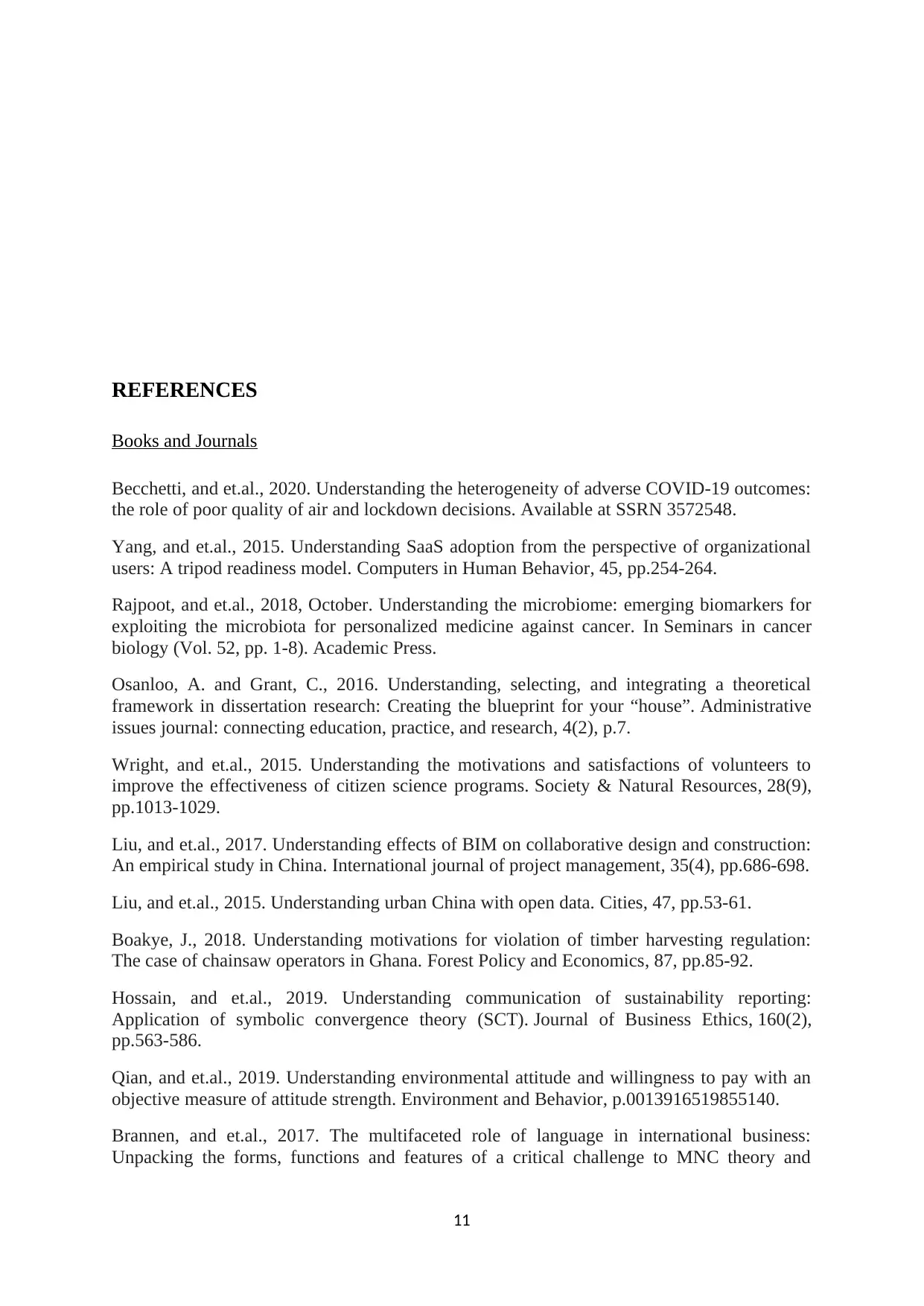
REFERENCES
Books and Journals
Becchetti, and et.al., 2020. Understanding the heterogeneity of adverse COVID-19 outcomes:
the role of poor quality of air and lockdown decisions. Available at SSRN 3572548.
Yang, and et.al., 2015. Understanding SaaS adoption from the perspective of organizational
users: A tripod readiness model. Computers in Human Behavior, 45, pp.254-264.
Rajpoot, and et.al., 2018, October. Understanding the microbiome: emerging biomarkers for
exploiting the microbiota for personalized medicine against cancer. In Seminars in cancer
biology (Vol. 52, pp. 1-8). Academic Press.
Osanloo, A. and Grant, C., 2016. Understanding, selecting, and integrating a theoretical
framework in dissertation research: Creating the blueprint for your “house”. Administrative
issues journal: connecting education, practice, and research, 4(2), p.7.
Wright, and et.al., 2015. Understanding the motivations and satisfactions of volunteers to
improve the effectiveness of citizen science programs. Society & Natural Resources, 28(9),
pp.1013-1029.
Liu, and et.al., 2017. Understanding effects of BIM on collaborative design and construction:
An empirical study in China. International journal of project management, 35(4), pp.686-698.
Liu, and et.al., 2015. Understanding urban China with open data. Cities, 47, pp.53-61.
Boakye, J., 2018. Understanding motivations for violation of timber harvesting regulation:
The case of chainsaw operators in Ghana. Forest Policy and Economics, 87, pp.85-92.
Hossain, and et.al., 2019. Understanding communication of sustainability reporting:
Application of symbolic convergence theory (SCT). Journal of Business Ethics, 160(2),
pp.563-586.
Qian, and et.al., 2019. Understanding environmental attitude and willingness to pay with an
objective measure of attitude strength. Environment and Behavior, p.0013916519855140.
Brannen, and et.al., 2017. The multifaceted role of language in international business:
Unpacking the forms, functions and features of a critical challenge to MNC theory and
11
Books and Journals
Becchetti, and et.al., 2020. Understanding the heterogeneity of adverse COVID-19 outcomes:
the role of poor quality of air and lockdown decisions. Available at SSRN 3572548.
Yang, and et.al., 2015. Understanding SaaS adoption from the perspective of organizational
users: A tripod readiness model. Computers in Human Behavior, 45, pp.254-264.
Rajpoot, and et.al., 2018, October. Understanding the microbiome: emerging biomarkers for
exploiting the microbiota for personalized medicine against cancer. In Seminars in cancer
biology (Vol. 52, pp. 1-8). Academic Press.
Osanloo, A. and Grant, C., 2016. Understanding, selecting, and integrating a theoretical
framework in dissertation research: Creating the blueprint for your “house”. Administrative
issues journal: connecting education, practice, and research, 4(2), p.7.
Wright, and et.al., 2015. Understanding the motivations and satisfactions of volunteers to
improve the effectiveness of citizen science programs. Society & Natural Resources, 28(9),
pp.1013-1029.
Liu, and et.al., 2017. Understanding effects of BIM on collaborative design and construction:
An empirical study in China. International journal of project management, 35(4), pp.686-698.
Liu, and et.al., 2015. Understanding urban China with open data. Cities, 47, pp.53-61.
Boakye, J., 2018. Understanding motivations for violation of timber harvesting regulation:
The case of chainsaw operators in Ghana. Forest Policy and Economics, 87, pp.85-92.
Hossain, and et.al., 2019. Understanding communication of sustainability reporting:
Application of symbolic convergence theory (SCT). Journal of Business Ethics, 160(2),
pp.563-586.
Qian, and et.al., 2019. Understanding environmental attitude and willingness to pay with an
objective measure of attitude strength. Environment and Behavior, p.0013916519855140.
Brannen, and et.al., 2017. The multifaceted role of language in international business:
Unpacking the forms, functions and features of a critical challenge to MNC theory and
11
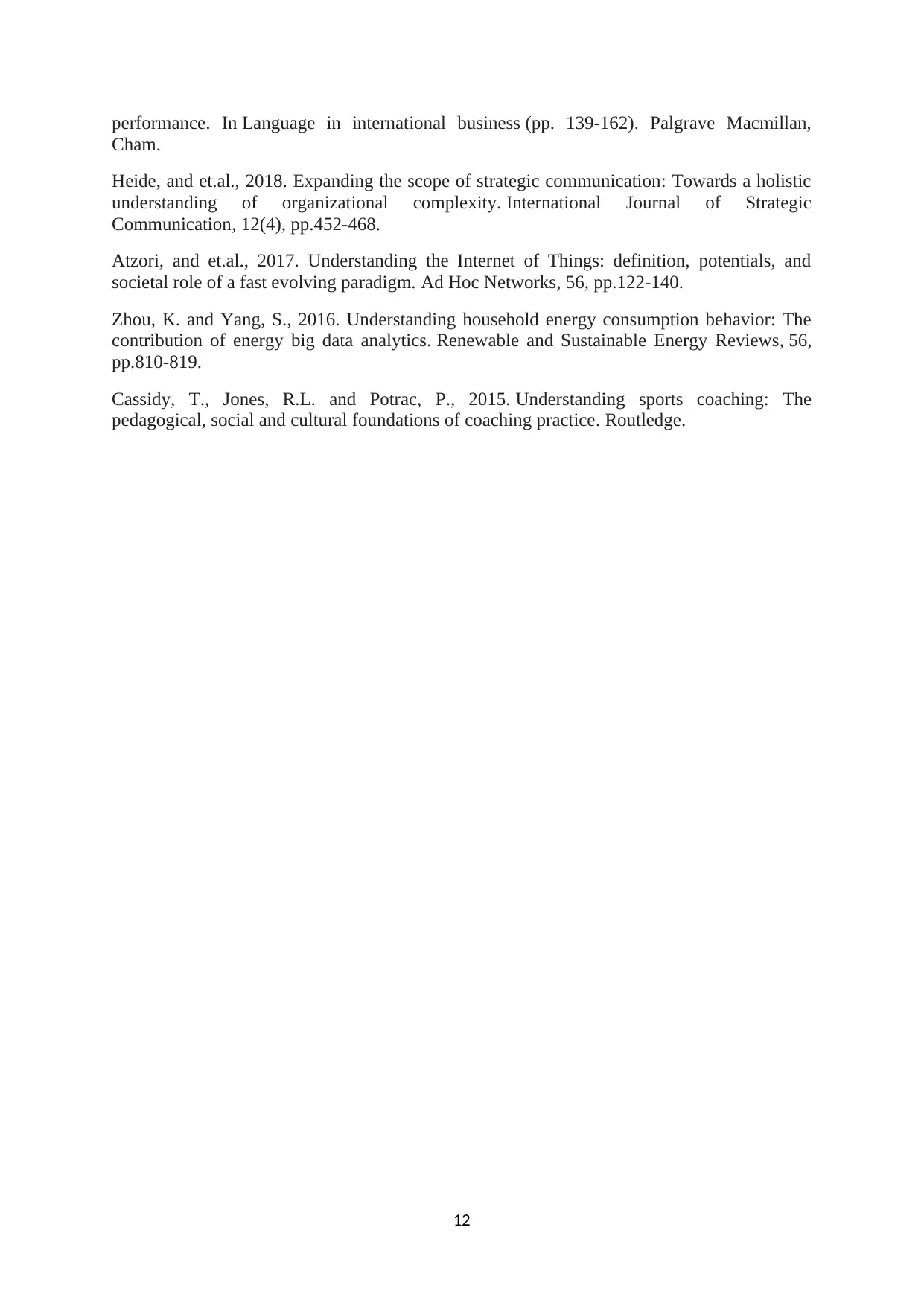
performance. In Language in international business (pp. 139-162). Palgrave Macmillan,
Cham.
Heide, and et.al., 2018. Expanding the scope of strategic communication: Towards a holistic
understanding of organizational complexity. International Journal of Strategic
Communication, 12(4), pp.452-468.
Atzori, and et.al., 2017. Understanding the Internet of Things: definition, potentials, and
societal role of a fast evolving paradigm. Ad Hoc Networks, 56, pp.122-140.
Zhou, K. and Yang, S., 2016. Understanding household energy consumption behavior: The
contribution of energy big data analytics. Renewable and Sustainable Energy Reviews, 56,
pp.810-819.
Cassidy, T., Jones, R.L. and Potrac, P., 2015. Understanding sports coaching: The
pedagogical, social and cultural foundations of coaching practice. Routledge.
12
Cham.
Heide, and et.al., 2018. Expanding the scope of strategic communication: Towards a holistic
understanding of organizational complexity. International Journal of Strategic
Communication, 12(4), pp.452-468.
Atzori, and et.al., 2017. Understanding the Internet of Things: definition, potentials, and
societal role of a fast evolving paradigm. Ad Hoc Networks, 56, pp.122-140.
Zhou, K. and Yang, S., 2016. Understanding household energy consumption behavior: The
contribution of energy big data analytics. Renewable and Sustainable Energy Reviews, 56,
pp.810-819.
Cassidy, T., Jones, R.L. and Potrac, P., 2015. Understanding sports coaching: The
pedagogical, social and cultural foundations of coaching practice. Routledge.
12
⊘ This is a preview!⊘
Do you want full access?
Subscribe today to unlock all pages.

Trusted by 1+ million students worldwide
1 out of 12
Related Documents
Your All-in-One AI-Powered Toolkit for Academic Success.
+13062052269
info@desklib.com
Available 24*7 on WhatsApp / Email
![[object Object]](/_next/static/media/star-bottom.7253800d.svg)
Unlock your academic potential
Copyright © 2020–2025 A2Z Services. All Rights Reserved. Developed and managed by ZUCOL.





